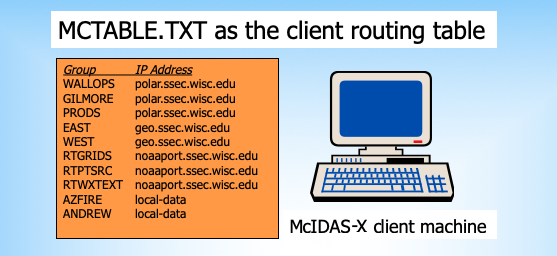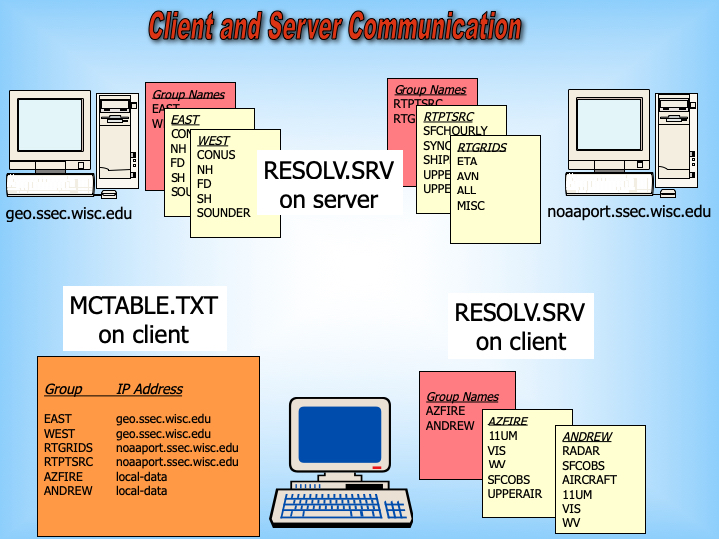
McIDAS-X Learning Guide
Version 2020
[Search Manual] [Table of Contents] [Go to Previous] [Go to Next]
Each ADDE client command starts a transaction by requesting data from a server. Both the client and server must recognize the command's specified dataset name in their look-up tables. On the client, this table is called the routing table because it determines which server to route the data request to. The client routing table contains two lists: a list of group names with their associated server IP addresses, and a list of aliases with the dataset names they represent. See Figure 1.
Figure 1. When groups are assigned server IP addresses with the DATALOC command, the entries are saved in MCTABLE.TXT.
Use the DATALOC command to manage the list of group names. Use the AKA command to manage the list of aliases. Aliases allow you to use a short, easily remembered name to represent a dataset name in other ADDE commands. You can use this alias regardless of which server the dataset is stored on. For example, you could create the alias G16FD to represent the dataset name SSEC-RT/G16-FULLDISK.
Each user can access multiple client routing tables. This optional feature is useful when a site table has the default routing information and alias names for all users, and each user has a local table with individualized routing information and alias names. The default file for your local table is MCTABLE.TXT. The site table, if it exists, is maintained by your site administrator or operations staff and is usually write-protected so you can't modify it. Use the DATALOC and AKA commands to list information from all the client routing tables accessible to you.
If you decide to use multiple client routing tables, you must set the Unix environment variables MCTABLE_READ and MCTABLE_WRITE. See the McIDAS User's Guide for more information on using multiple routing tables.
When you enter an ADDE command, the client routing table is scanned for an entry with the specified group name or alias. If an entry is found, the data request is routed to the server specified in the entry. If the group name or alias is not found in the client routing table, the request is routed to the local server.
When naming data on your local server, you must use group names that are not mapped to other servers in your client routing table. Use the command entry DATALOC LIST to list the group names in your client routing table. Since ADDE commands that request data from a group name not found in the client routing table are automatically routed to the local server, you do not have to add your local server's group names to the table.
To summarize, the server mapping table maps dataset names to the files that make up the datasets. On the server, this table is called the mapping table because it maps the group and descriptor to a specific image, grid, point, navigation or text dataset. When the server receives a data request from a client, it reads the mapping table to locate the correct dataset. The server sends the requested data back to the client so it can list or display the data. See Figure 2.
Figure 2. An overview of how the client and server system files work together to serve and display data.
[Search Manual] [Table of Contents] [Go to Previous] [Go to Next]